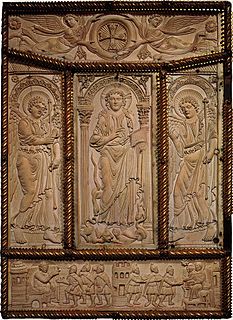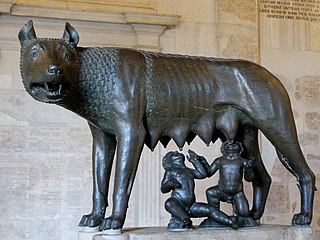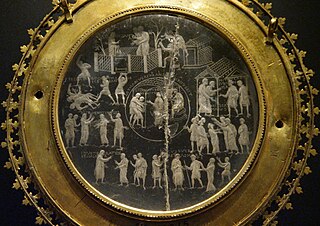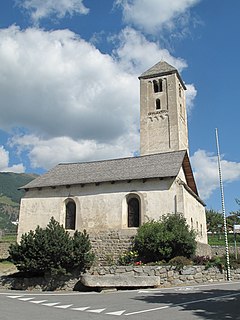 W
WCarolingian art comes from the Frankish Empire in the period of roughly 120 years from about 780 to 900—during the reign of Charlemagne and his immediate heirs—popularly known as the Carolingian Renaissance. The art was produced by and for the court circle and a group of important monasteries under Imperial patronage; survivals from outside this charmed circle show a considerable drop in quality of workmanship and sophistication of design. The art was produced in several centres in what are now France, Germany, Austria, northern Italy and the Low Countries, and received considerable influence, via continental mission centres, from the Insular art of the British Isles, as well as a number of Byzantine artists who appear to have been resident in Carolingian centres.
 W
WThe Ardennes Cross is a wooden processional cross from the Carolingian period, said to originate in a monastery in the Luxembourg Ardennes. Since 1894 it has been in the Germanisches Nationalmuseum in Nuremberg.
 W
WThe Capitoline Wolf is a bronze sculpture depicting a scene from the legend of the founding of Rome. The sculpture shows a she-wolf suckling the mythical twin founders of Rome, Romulus and Remus. According to the legend, when King Numitor, grandfather of the twins, was overthrown by his brother Amulius in Alba Longa, the usurper ordered them to be cast into the Tiber River. They were rescued by a she-wolf that cared for them until a herdsman, Faustulus, found and raised them.
 W
WThe Carolingian G or French G (𝗴) is the evolved classical form of the letter G that was in use in most Middle English alphabets. The other form scholars and writers familiar with Celtic Britain generally knew and could use, and in the furthest places in Britain away from England exclusively used domestically, was the insular G, which could bear a well-understood extra phonetic sense, when writing of the local people, places and language. Unlike the vowel u and consonants which could appear ambiguous such as s, it had no special rules as to choice of letter in Middle English orthography.
 W
WBritish Library, Add MS 11848 is an illuminated Carolingian Latin Gospel Book produced at Tours. It contains the Vulgate translation of the four Gospels written on vellum in Carolingian minuscule with Square and Rustic Capitals and Uncials as display scripts. The manuscript has 219 extant folios which measure approximately 330 by 230 mm. The text is written in area of about 205 by 127 mm. In addition to the text of the Gospels, the manuscript contains the letter of St. Jerome to Pope Damasus and of Eusebius of Caesarea to Carpian, along with the Eusebian canon tables. There are prologues and capitula lists before each Gospel. A table of readings for the year was added, probably between 1675 and 1749, to the end of the volume. This is followed by a list of capitula incipits and a word grid which were added in the Carolingian period.
 W
WCarolingian minuscule or Caroline minuscule is a script which developed as a calligraphic standard in the medieval European period so that the Latin alphabet of Jerome's Vulgate Bible could be easily recognized by the literate class from one region to another. It is thought to have originated before AD 778 at the scriptorium of the Benedictine monks of Corbie Abbey, and then developed by Alcuin of York for wide use in the Carolingian Renaissance. However, the script Alcuin wrote was still not the Carolingian minuscule, which slowly developed over three centuries. He was most likely responsible for copying and preserving the manuscripts and upkeep of the script. It was used in the Holy Roman Empire between approximately 800 and 1200. Codices, pagan and Christian texts, and educational material were written in Carolingian minuscule.
 W
WThe Vatican Terence, or Codex Vaticanus Latinus 3868, is a 9th-century illuminated manuscript of the Latin comedies of Publius Terentius Afer, housed in the Vatican Library. According to art-historical analysis the manuscript was copied from a model of the 3rd century.
 W
WA disc fibula or disc brooch is a type of fibula, that is, a brooch, clip or pin used to fasten clothing that has a disc-shaped, often richly decorated plate or disc covering the fastener. The terms are mostly used in relation to the Middle Ages of Europe, especially the earlier part of the period. They were the most common style of Anglo-Saxon brooches.
 W
WA Carolingian-era equestrian statuette in bronze depicting either Charlemagne or his grandson Charles the Bald, a rare example of surviving Carolingian sculpture in metal, is exhibited in the Louvre Museum. In the 16th, 17th and 18th centuries it was kept in Metz Cathedral.
 W
WGermigny-des-Prés is a commune in the Loiret department in north-central France.
 W
WLeiden, Universiteitsbibliotheek, VLQ 79, also called the Leiden Aratea, is an illuminated copy of an astronomical treatise by Germanicus, based on the Phaenomena of Aratus. The manuscript was created in the region of Lorraine and has been dated to around 816. It was produced at the court of Louis the Pious, who ruled from 814–840. It is one of the four Carolingian codices that were produced in his court. There are many translations and copies of this text, so it is very well known throughout the Middle East and Europe.
 W
WLombardic capitals is the name given to a type of decorative upper-case letters used in inscriptions and, typically, at the start of a section of text in medieval manuscripts. They are characterized by their rounded forms with thick, curved stems. Paul Shaw describes the style as a "relative" of uncial writing.
 W
WThe Lothair Crystal is an engraved gem from Lotharingia in northwest Europe, showing scenes of the biblical story of Susanna, dating from 855–869. The Lothair Crystal is an object in the collection of the British Museum.
 W
WThe Carolingian Renaissance was the first of three medieval renaissances, a period of cultural activity in the Carolingian Empire. It occurred from the late 8th century to the 9th century, taking inspiration from the Christian Roman Empire of the fourth century. During this period, there was an increase of literature, writing, the arts, architecture, jurisprudence, liturgical reforms, and scriptural studies.
 W
WThe Saint-Denis Crystal or Cristal de Saint-Denis is a Caroligian engraved gem depicting the crucifixion of Christ, that was originally held in the treasury of the Abbey of Saint-Denis in France. During the French Revolution many pieces in the Abbey's treasure were either broken up and destroyed or sold - the Saint Denis Crystal eventually made its way to the British Museum in London, where it resides to this day.
 W
WSignum manus refers to the medieval practice, current from the Merovingian period until the 14th century in the Frankish Empire and its successors, of signing a document or charter with a special type of monogram or royal cypher.
 W
WSt. Benedikt is a pre-Romanesque church in Mals, South Tyrol, known for its Carolingian-era frescoes.
 W
WThe Talisman of Charlemagne is a 9th-century Carolingian reliquary encolpion that may once have belonged to Charlemagne and is purported to contain a fragment of the True Cross. It is the only surviving piece of goldwork which can be connected with Charlemagne himself with some degree of probability, but the connection has been questioned. The talisman is now kept in Rheims in the Palace of Tau.
 W
WThe Vienna Coronation Gospels, also known simply as the Coronation Gospels, is a late 8th century illuminated Gospel Book produced at the court of Charlemagne in Aachen. It was used by the future emperor at his coronation on Christmas Day 800, when he placed three fingers of his right hand on the first page of the Gospel of Saint John and took his oath. Traditionally, it is considered to be the same manuscript that was found in the tomb of Charlemagne when it was opened in the year 1000 by Emperor Otto III. The Coronation Evangeliar cover was created by Hans von Reutlingen, c. 1500. The Coronation Evangeliar is part of the Imperial Treasury (Schatzkammer) in the Hofburg Palace in Vienna, Austria.
 W
WSaint Peter's church (Saint-Pierre-le-Bas) in Vienne is one of the oldest surviving churches in France, situated in the Rhône-Alpes region. The church was added to the 1862 version of the list of France's Monuments historiques, created in 1819.